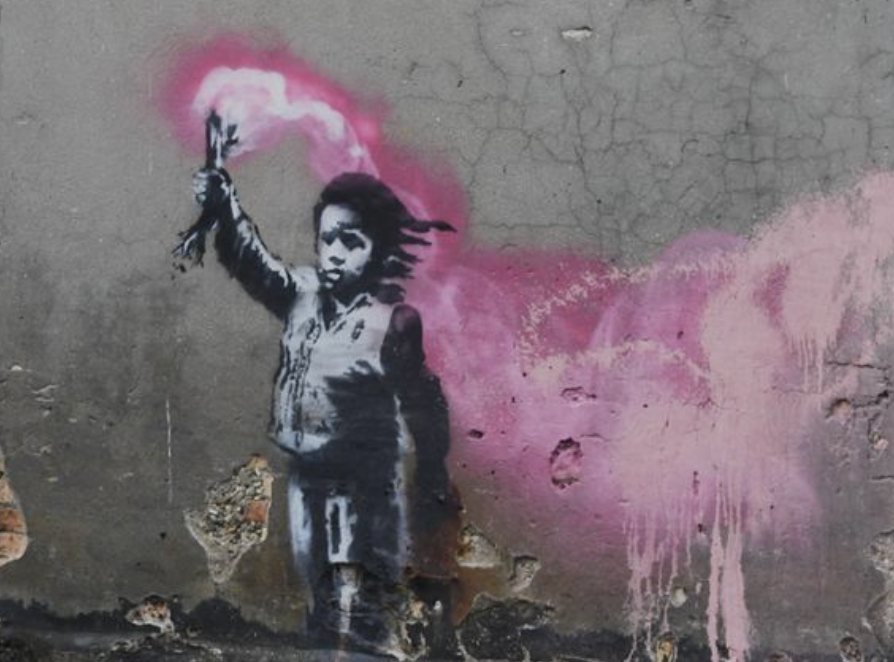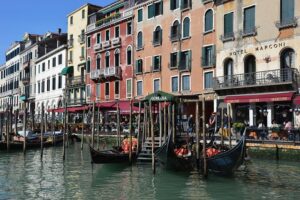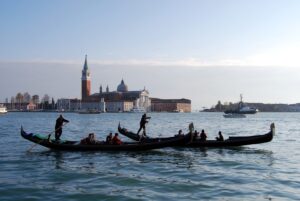Banksy in Venice: When Street Art Met the Floating City
Venice has always been a magnet for artists — from Titian to Turner, from Canaletto to Monet. Its reflection-filled canals and fading palazzi have inspired masterpieces for centuries. But in May 2019, something entirely different happened: a quiet rebellion of paint and purpose.
One morning, residents of the Floating City awoke to find new art on their ancient walls — not from an Italian maestro, but from the world’s most elusive street artist: Banksy. His visit — unannounced, unauthorized, and unforgettable — left an indelible mark on Venice’s artistic landscape and reignited debates about tourism, environment, and authenticity in a city already struggling to stay afloat, both literally and figuratively.
🕶️ The Phantom Painter: Who Is Banksy?
For over two decades, Banksy has been the art world’s most captivating enigma. His identity remains a secret — hidden behind hoodies, pseudonyms, and whispers. Yet his works are instantly recognizable: bold stencils blending dark humor, social criticism, and raw humanity.
Emerging from Bristol’s underground scene in the 1990s, Banksy’s art evolved from graffiti rebellion to global commentary. His subjects — children, policemen, rats, and refugees — speak of inequality, war, greed, and hope. And though he’s painted on walls from London to Bethlehem, Paris to New York, his art transcends geography. It lives in conversation with its surroundings — which is precisely why his arrival in Venice made such perfect, poetic sense.
Because Venice, too, is a contradiction: a city of beauty and fragility, wealth and decay, fame and exhaustion. The moment Banksy’s spray can touched Venetian plaster, the world paid attention — again.
🚤 Venice Calling: Why Here, Why Then?
In May 2019, the Venice Biennale — the world’s most prestigious art exhibition — was underway. Galleries, critics, collectors, and influencers had descended upon the lagoon to celebrate the avant-garde. And amid the curated installations and velvet ropes, Banksy did what Banksy always does: showed up uninvited.
He didn’t request a booth, didn’t apply for approval, didn’t announce a show. Instead, he set up a street stall near St. Mark’s Square, displaying a series of canvases depicting a giant cruise ship looming over the city’s skyline. The piece, titled “Venice in Oil”, was a sharp commentary — part environmental protest, part artistic satire. Ironically, local police soon removed his setup, citing “lack of a permit.” The artist, true to form, later posted a video of the incident on his Instagram, ending with the wry caption: “Despite being the largest and most prestigious art event in the world, for some reason I’ve never been invited.”
That moment — half absurd, half profound — encapsulated everything about Venice and Banksy: beauty clashing with bureaucracy, rebellion confronting ritual, truth hiding in plain sight.
🖼️ “Venice in Oil”: A Mirror on the Grand Canal
Perhaps the most famous of Banksy’s Venetian interventions, “Venice in Oil” was both painting and performance. Nine framed oil canvases, when placed side by side, formed a panoramic image of a monstrous cruise ship dwarfing Venice’s skyline — gondolas in the foreground, overwhelmed by industrial excess.
It was a hauntingly accurate metaphor. At the time, cruise ships weighing over 100,000 tons were sailing directly through the Giudecca Canal, past St. Mark’s Square, displacing lagoon waters and shaking centuries-old foundations. Locals protested. Politicians argued. The world watched — briefly — before scrolling on.
Then Banksy came along, and his message hit home. By juxtaposing romantic oil painting with biting irony, he reminded us that Venice’s eternal beauty was being consumed by the very industry profiting from it. The irony was perfect: an uninvited artist doing what sanctioned institutions could not — holding a mirror up to Venice’s painful paradox.
It was art in its purest form: disruptive, beautiful, and impossible to ignore.
🧒 The Refugee Child: A Cry from the Lagoon
Days later, another Banksy piece appeared — this time stenciled directly onto a building wall along the Grand Canal, near the Campo San Pantalon area. It depicted a small child wearing a pink life jacket, holding a neon distress flare that cast an eerie red glow over the water.
The image — later confirmed by Banksy himself — became known as “The Refugee Child”. It was subtle yet piercing, appearing as if the girl were signaling for help from the sinking city itself. To Venetians, it resonated on multiple levels: as a reflection of the global refugee crisis and as a symbolic plea for Venice’s own survival amid rising tides and overtourism.
Visitors flocked to the site. Locals guarded it. And despite vandalism attempts, the piece remains one of Venice’s most haunting works of contemporary art — a permanent echo of an artist who was never meant to stay.
🚢 Gondolas, Garbage, and the Modern Plague of Overtourism
Banksy’s themes have always extended beyond walls — and Venice’s canals provided the perfect canvas. In several guerrilla-style performances, locals reported seeing a small gondola filled with trash, floating through the lagoon like a tragic parody of a romantic ride. While not officially confirmed as Banksy’s doing, the imagery aligned perfectly with his visual lexicon: ironic, devastating, unforgettable.
Venice has long struggled with pollution, cruise traffic, and waste management. The sight of a garbage-laden gondola was a brutal reminder that behind every picture-perfect Instagram post lies a complex ecosystem at risk. And just like his London rats or Bethlehem walls, Banksy used Venice’s own symbols — gondolas, canals, masks — to expose what many prefer to ignore.
💬 The Conversation He Sparked
Banksy’s brief visit ignited a fierce debate that rippled through Venice’s narrow alleys and echoing palaces. Some hailed his work as the most relevant commentary of the entire Biennale. Others accused him of exploiting the city’s struggles for fame.
Art critics, predictably, divided into camps. Traditionalists dismissed the stunt as opportunistic. Younger audiences, however, celebrated it as a powerful act of public art — one that bypassed elitist institutions and spoke directly to people in the streets.
Venetians themselves felt something different: validation. For once, someone had articulated — in paint — what locals had been shouting for years: that their city, their home, was being turned into a theme park, and that beauty was becoming a commodity. Banksy’s voice, though foreign, carried their grief and frustration across the world’s headlines.
🌍 Banksy, Venice, and the Global Stage
Banksy’s Venice episode wasn’t just about art — it was about visibility. Within days, his works appeared in international news outlets, on social media feeds, and in global conversations about overtourism, climate change, and cultural preservation. Venice became, once again, a metaphor for our collective fragility.
His art challenged both locals and visitors to rethink their roles. Are we protectors or consumers? Witnesses or participants? And for many who saw his works in person, that question lingered long after they left.
Even the city’s governing officials, often slow to react, began to implement stricter controls on cruise traffic and visitor management. While Banksy didn’t cause policy shifts singlehandedly, he amplified a message that could no longer be ignored — a message that echoed across the lagoon like a flare in the night sky.
📷 Art, Tourism, and the Venice Paradox
Venice has always walked a delicate line between preservation and performance. Millions arrive each year to marvel at its art, yet their very presence accelerates its decay. Banksy’s interventions cut straight through this paradox. His pieces reminded us that beauty is not infinite — that cities, like canvases, can be overpainted to the point of disappearance.
He forced a dialogue that institutions often avoid: How do we protect the fragile balance between tourism and authenticity? How do we ensure Venice remains a city — not a stage set?
At Tour Leader Venice, these questions shape how we guide travelers every day. Through our Off-the-Beaten-Path Tours and Cicchetti & Wine Experiences, we show guests the quieter Venice — the artisan workshops, hidden courtyards, and local stories that still resist mass tourism. Because if Banksy’s art taught us anything, it’s that every city needs its defenders as much as its admirers.
🧩 Symbolism and Storytelling: Decoding Banksy’s Venetian Messages
Each piece left behind in Venice carried multiple meanings:
- “Venice in Oil” — A critique of climate change, capitalism, and mass tourism, wrapped in irony and beauty.
- “The Refugee Child” — A plea for empathy amid a humanitarian crisis and a metaphor for a drowning city.
- The Gondola with Garbage — A reflection of environmental negligence and the commercialization of heritage.
- The Street Stall Eviction — A performance piece exposing bureaucracy’s absurdity in the face of artistic truth.
Each was ephemeral, yet unforgettable. In Venice, a city that has endured floods, wars, and centuries of change, this fleeting art found a fitting stage — one where impermanence is part of the poetry.
⚓ Echoes That Remain
Years later, the pieces themselves have faded or been partially damaged — but their echo remains. Visitors still ask about them on walking tours; locals still tell stories of that week when Banksy turned Venice into his open-air gallery.
For some, it was a stunt. For others, a revolution. For Venice, it was both — and something more: a moment of collective self-reflection.
As floods return, as debates about cruise ships and tourism intensify, Banksy’s message only grows louder: beauty needs protection. And perhaps that’s the real masterpiece — not the painting, but the conversation it continues to inspire.
🌅 A Local’s Reflection: When the Lagoon Speaks Back
As Venetian guides, we often pass the wall where The Refugee Child still peers out at the canal. Guests pause, cameras in hand, and whisper: “Is it really by Banksy?” And we smile — because whether or not it is, the message remains powerful. Venice doesn’t need a signature to tell its truth.
In many ways, Banksy became part of the city’s long tradition of anonymous artistry. From medieval craftsmen who carved saints into bridges to modern artisans at Murano glass furnaces, Venice has always celebrated creators who work not for fame, but for expression.
That’s why his art feels at home here. It doesn’t scream; it whispers. It fades with the tide, just like everything else in this city built on impermanence.
🏛️ The Biennale Connection: When Institutions and Rebels Collide
It’s impossible to talk about Banksy’s visit without acknowledging the irony of its timing. The Venice Biennale — established in 1895 — represents the epitome of official, institutionalized art. Banksy’s guerrilla performance outside its gates was both homage and rebellion. It questioned who gets to define “art” and who decides where it belongs.
In many ways, he succeeded where others could not: he reminded the world that creativity doesn’t require permission. And in a city where art once shaped empires, it was a timely reminder that innovation often begins outside the system.
If you visit Venice during the next Biennale, consider exploring beyond the pavilions. Our Lagoon Tour takes you to places where art still breathes — from Torcello’s ancient mosaics to contemporary studios hidden on Giudecca Island. It’s there, in the silence between tides, that you’ll find the spirit Banksy was speaking to.
💡 Lessons from the Wall: What Banksy Taught Venice
Five years on, what remains of Banksy’s Venetian adventure?
- That art belongs to everyone — not just museums and collectors.
- That beauty and fragility are intertwined, especially in places like Venice.
- That silence is complicity — even graffiti can be a form of activism.
- That the city itself is an artist — its tides, reflections, and whispers are the greatest masterpiece of all.
And perhaps the greatest irony: Banksy came, painted, left — and Venice, in all her contradictions, carried on. But she was changed, just a little. Her story gained a new chapter, one where rebellion met reflection on the world’s most delicate stage.
📍 Visiting Banksy’s Venice Today
Although many of the original works have faded, the Refugee Child still draws visitors to Dorsoduro’s quiet canal banks. To find it, follow your curiosity rather than a map. Let yourself wander — because getting lost in Venice is part of the art.
Pair your exploration with a Walking Tour Off the Beaten Path or a Private Boat Tour through the lesser-known canals. Our guides — locals born and raised in the lagoon — will help you see what Banksy saw: not just a postcard city, but a living, breathing organism balancing art and survival.
🏁 Conclusion: The City, the Artist, and the Echo
When Banksy visited Venice in 2019, he didn’t just leave behind art — he left a challenge. He asked us to look closer: at the waters rising beneath our feet, at the faces of those displaced, at the irony of celebrating art while ignoring what endangers it.
Venice, in turn, absorbed his message like she always does — with grace, melancholy, and quiet defiance.
Today, the Refugee Child still gazes over the canal, flare in hand, calling out to a world that moves too fast. And somewhere, perhaps, Banksy is smiling — because in this city of masks, anonymity feels like home.
🎨 Explore Venice’s Art and Hidden Stories with Tour Leader Venice
🍷 Join Our Venice Wine & Culture Experience
🚶 Walk the Hidden Venice Banksy Walk with a Local
Art fades. Water rises. But stories — and Venice — endure forever.
FAQs
Where can I see Banksy’s artwork in Venice?
The most famous remaining piece, The Refugee Child, is located along a canal near Campo San Pantalon in the Dorsoduro district. It depicts a young girl wearing a life jacket and holding a pink flare — a haunting symbol of both the refugee crisis and Venice’s fragility. Though the painting has faded slightly, it’s still visible and often visited during off-the-beaten-path walking tours.
Did Banksy really create the artwork in Venice during the Biennale?
Yes. In May 2019, during the Venice Biennale, Banksy confirmed via his official Instagram account that he was behind the stencil of The Refugee Child and the performance piece Venice in Oil. His video showed him being removed by police after setting up an unauthorized art stall near St. Mark’s Square — a classic Banksy moment blending irony, h
What message did Banksy’s Venice works convey?
Banksy’s pieces in Venice criticized mass tourism, climate change, and social indifference. Venice in Oil condemned cruise-ship pollution and overtourism, while The Refugee Child symbolized both humanitarian crises and the city’s struggle for survival. His visit reminded the world that art doesn’t always need permission — and that Venice’s beauty is as fragile as it is eternal.







